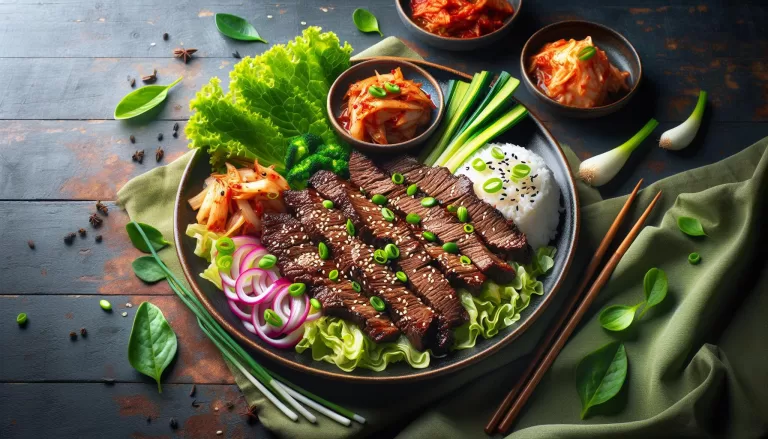Healthful Homemade Galbitang Recipe- Beef Short Rib Soup for Enhanced Nutrition

Ingredients for Homemade Beef Short Rib Soup Galbitang
Let’s uncover what’s needed to get your galbitang bubbling.
For starters, you’ll need 2 pounds of beef short ribs. Make sure you’ve got a noteworthy and high-quality cut; after all, it’s the superstar of this soul-soothing dish. To add a depth of flavor, grab 10 cloves of garlic, peeled and minced.
An underrated ingredient that adds a rich depth to this soup is asian radish, also known as Mu or Daikon. You’ll need approximately 2 cups of this, peeled and chopped. Got some lying around? Perfect. No Mu or Daikon? No sweat. Feel free to substitute with any variety of radish or turnips.
Next, you’ll want to add a finishing touch of freshness and crunch. That’s where 2 green onions, chopped, and 2 cups of Napa cabbage, sliced, come into play. While not commonly considered, 1 teaspoon of black pepper gives that slight punch, making every sip memorable.
Of course, what would a soup be without its soul – the broth? We’re bypassing the store-bought stuff and going homemade. You’ll require 10 cups of water to start.
Here’s your easy-to-follow list of ingredients:
| Ingredients | Quantity |
|---|---|
| Beef short ribs | 2 pounds |
| Garlic | 10 cloves (minced) |
| Asian Radish (Mu or Daikon) | 2 cups (peeled/chopped) |
| Green onions | 2 (chopped) |
| Napa cabbage | 2 cups (sliced) |
| Black pepper | 1 tsp |
| Water | 10 cups |
Step-by-Step Instructions for Making Galbitang

Kick start your culinary voyage by preparing your ingredients. Grab your 2 pounds of beef short ribs. Make sure they’re good quality – it’s the star of your dish. Rinse the ribs under cool water then soak them in a large pot of cold water. Leave the ribs submerged for about an hour to draw out excess blood and impurities.
While your ribs are relaxing, take this time to peel and chop 6 cloves of garlic and slice your Asian radish into 1/2-inch thick slices. Freshness counts – the sharp, crisp flavors will add a certain zing to your soup.
Go back to your short ribs after their hour-long soak. Drain the water, rinse the ribs once more then fill the pot again with 10 cups of cold water. Add the ribs once more along with sliced Asian radish and garlic you prepped earlier.
You’re ready to heat things up. Bring your pot to a boil over high heat and let it vigorously boil for about 10 minutes. This process will help to remove any remaining impurities. Do skim off any scum that surfaces. After 10 minutes, reduce the heat to medium-low and let it simmer.
Look at the clock – slow-cooking the ribs for at least 2 hours will bring out their flavor. You’ll see your ribs transform into tender morsels, with a rich and robust broth as a result.
In the meantime, prep your green onions and Napa cabbage. Clean, trim, and chop them into pieces. Add them to your simmering pot in the last 30 minutes of cooking. They’ll add a delightful crunch and color to your soup.
Finally, season the soup with 1 to 1.5 teaspoons of salt and some black pepper to taste. Ladle your soup into your bowls and make sure to get some short ribs, radish, and green onions in each serving.
And there you go! You’ve just made your own Galbitang. Savor the homemade goodness of the beefy, subtly sweet, and invigorating flavors of this heartwarming Korean soup. Trust us – it’s a taste experience worth every minute.
Tips for Enhancing the Flavor of Your Galbitang

Making a pot of Galbitang that’s bursting with flavor involves more than just boiling ribs and vegetables. There’s a magic that happens when you master the art of balancing ingredients. We’ve gathered some practical tips that’ll enrich your culinary journey and lead to a beefy, subtly sweet Galbitang that’s unforgettable.
Choice of Beef plays a pivotal role. High-quality beef short ribs is the ideal option for this dish. With layers of meat, fat, and bone, they add depth and richness that’s hard to beat. Try sourcing local meat producers. Their quality often surpasses what you’d find at standard grocery stores. You may also marinate the ribs in an Asian pear puree. From experience, it helps tenderize the meat and adds a unique sweetness.
Thoroughly Soak the Beef. It’s vital to remove blood and impurities from the ribs before cooking. Soak them in cold water for a few hours or even overnight. This process not only improves taste but also gives the soup a clear, desirable look.
Timing is key when adding the vegetables. While it’s tempting to throw everything in at once, remember to hold back. Add your harder vegetables like radishes midway and soft ones like Napa cabbage and green onions towards the end. This way, your vegetables won’t overcook and lose their vibrant color and crisp texture.
Subtle Seasoning enhances the overall flavor without overpowering the main star – the beef. Traditional Galbitang uses minimal seasonings – usually just salt and black pepper. And there’s something beautiful about that simplicity. It allows the natural flavor of the beef and veggies to shine through.
Lastly, Tweak the Recipe to fit your taste buds. Some people love a fiery kick to their soup. If you do, add red pepper flakes or even a spoon of gochujang (Korean chili paste) while cooking. Similarly, adding some soybean paste or miso can add another level of depth to the soup.
Serving Suggestions and Pairings for Galbitang

Once you’ve perfected your galbitang recipe, the next step is figuring out the best way to serve it up. A steaming bowl of galbitang can be an entire meal by itself but pairing it with the right accompaniments can elevate the experience.
Firstly, hanbansang is a traditional Korean table setting. This involves balancing the five flavors – sweet, sour, salty, bitter, and spicy – across multiple dishes in the same meal. Use galbitang as the protein and balance the rest of your table with dishes like kimchi, pickled radish, and seasoned spinach. You’ll find that the robust flavor profile of the soup plays well against the sharpness of the pickles and the mellow flavor of the spinach.
Moving on to beverage pairings, soju is a clear, slightly sweet alcoholic beverage that pairs beautifully with galbitang. Its smooth texture and subtle flavors cut through the richness of the soup, balancing the palate and enhancing the beefy flavor. If alcohol isn’t your thing, green tea is another wonderful pairing. The bitter undertones of the tea offset the richness of the soup, creating a delightfully balanced flavor profile.
Ultimately, the choice about how to serve and pair your galbitang is yours. These suggestions can serve as a starting point, allowing you to add your own touch. Remember, food is an exploration, not something set in stone.
As you venture into plating this hearty Korean dish, you might want to experiment with different condiments that can add a personalized touch to your meal. Some popular galbitang accompaniments include yangnyeomjang (a spicy soy-based sauce) or salsig (a mixture of rice, barley, and ginseng). These condiments bring their own unique flavor, making each spoonful of galbitang all the more exciting.
Ultimately, the goal is to create an enjoyable and satisfying meal. With some thought into your serving suggestions and pairings, you’d be taking your cooking experience, and the resulting meal, to the next level.
Health Benefits of Homemade Beef Short Rib Soup

Roll up your sleeves and brace yourself for a dose of healthy choices. Galbitang, your homemade beef short rib soup, is not only indulging but also packed with a powerful mix of nutrients, making it a tasty choice for your well-being.
Consider the beef short ribs, the star in your dish. You’ll find protein here in spades. Each serving offers substantial amounts to keep you, your muscles, and tissues in prime condition. It’s a protein powerhouse, helping restore, repair and produce cells vital to your body’s functioning.
Then there’s the rib part, perfect for a tasty bone broth base. This is where collagen comes from; your secret anti-aging wonder. As you enjoy your homemade galbitang, you’re feeding your skin, hair, and nails. Broth made from ribs contains gelatin and other nutrients that can help improve joint health and reduce inflammation.
| Nutrient | Benefits |
|---|---|
| Protein | Cell Repair, Growth |
| Collagen | Skin, hair, nail health, Joint Health |
Suppose you opt for vegetables like Korean radish, Napa cabbage, or Shiitake mushrooms in your Galbitang. In that case, you’re adding a round of vitamins and minerals to your bowl: Vitamin C, magnesium, iron, and potassium. These enhance immunity, promote heart health, and maintain bone strength.
Your choice of whole grains for your side dish, whether it’s brown rice or whole wheat bread, adds a hefty dose of fiber. This heart-friendly ingredient can aid digestion, help control weight, and regulate blood sugar levels.
Adjusting the Nutrient Content: Your Control
Making Galbitang at home means you’re in charge of the nutrient deck. You choose what to include, exclude or increase. Want it low-sodium? Use less salt. Need more protein? Add more beef or even toss in some tofu. Need to reduce cholesterol? Skim off the fat from the soup before serving. Your homemade Galbitang, your rules.
With these health benefits, each spoonful of your homemade galbitang becomes not only a culinary treat but also a promise of good health. Enjoy your hearty, homemade Korean meal full of wholesome nutrients from each ingredient. Enjoy your Galbitang, knowing you’re nourishing your body with the best you can offer.
Conclusion
So, you’ve seen how homemade Galbitang is more than just a hearty meal. It’s also a health powerhouse, packed with protein, collagen, and a variety of essential nutrients. By making this beef short rib soup at home, you’re in the driver’s seat, tailoring the ingredients to your dietary needs. So why not give it a go? Not only will you be treating your taste buds to a culinary delight, but you’ll also be investing in your health. The beauty of Galbitang lies not only in its rich, savory flavor but also in the promise of wellness it brings to your table. So, get cooking and enjoy the healthful benefits of this delicious Korean soup right in your kitchen.




